Motorola Mobility T56XB1 Mobile Cellular Phone User Manual Safety regulatory legal
Motorola Mobility LLC Mobile Cellular Phone Safety regulatory legal
Contents
- 1. GSG Booklet User Manual
- 2. Safety, Regulatory, & Legal User Manual
- 3. Safety-regulatory-legal User Manual
Safety-regulatory-legal User Manual

1
Safety, regulatory, &
legal
Where is my legal, safety and regulatory information?
In order to
provide you with better access to this important information, we’ve made the
materials accessible from the phone’s settings menu and on the web. Please
review these materials prior to using your device. To access the materials
from a connected phone, go to
Settings
> System > Legal information
, and select a topic. To access the
materials on the web, visit www.motorola.com/device-legal.
Regulatory information (e-label).
Your mobile device may use an
electronic label (e-label) that provides some regulatory information about the
device. To view the regulatory information (such as FCC ID) for this device, on
the phone, go to
Settings
>
System
>
R
egula
t
ory
information
, or visit
www.motorola.com/device-legal.
Battery charging.
Charge your mobile device using a compatible Motorola
charger, another brand class 2 Limited Power Source USB charger that
complies with USB 1.1, 2.0, 3.0, or greater, and complies with EN301489-34,
EN60950-1 or equivalent, or a high-power USB port on a PC. Chargers that do
not comply with these standards may be unsafe and may cause slow charging,
product damage, or reduced device performance.
• Your mobile device will not charge if the temperature is too high or low.
• Only use Motorola-approved batteries, which contain safety circuitry and
are designed to give the best performance in your mobile device.
• Don.’t use a damaged charger or charger cable to charge your device.
• Don’t use tools, sharp objects, or excessive force to clean the USB
port, as this may damage your mobile device.
Distractions.
Using your mobile device in some circumstances could
distract you and may cause a dangerous situation. Be aware of your
surroundings and environmental hazards when using your mobile device.
Driving precautions.
Responsible and safe driving is your primary
responsibility when driving a vehicle. Always obey local laws and
regulations.
Seizures, blackouts, eyestrain & discomfort.
Prolonged use of any device
may cause discomfort in hands, fingers, arms, neck, and other parts of your
body, and may cause eyestrain and headaches. It is good practice to use your
device in a safe area with comfortable ambient lighting, and take frequent
breaks if you feel discomfort. Seek medical advice if symptoms persist.
In rare cases, flashing patterns or lights, for example in video games or
movies,
may cause seizures or blackouts. If you suffer any seizures or blackouts, or
have a history of seizures, stop using your device and seek medical advice.
2
Medical devices.
If you use an implantable pacemaker or defibrillator, or
other medical device, consult your healthcare provider and the device
manufacturer’s directions before using this mobile device.
If you use a pacemaker or defibrillator, the FCC recommends that you observe
the following precautions:
• ALWAYS keep the mobile device more than 20 centimeters (8 inches)
from the pacemaker or defibrillator.
• Use the ear opposite the pacemaker or defibrillator to minimize the
potential for interference.
• Turn OFF the mobile device immediately if you have any reason to suspect
that interference is taking place.
Important:
Some products contain magnets. Always keep products with
magnets more than 20 cm. (8 in.) from medical devices, such as pacemakers,
internal cardio defibrillators or other devices that can
be affected by a magnetic field. Also, keep away from credit cards, ID
cards and other media that use magnetically encoded information.
Children and animals. Keep your mobile device and its accessories
away from small children and animals.
These products are not toys and
maybe hazardous to small children and animals. For example, a choking
hazard may exist for small, detachable parts. Keep plastic bags away from
babies and children to avoid danger of suffocation and choking.
Supervise
access.
If children use your mobile device and accessories, monitor their
access for their safety, and to help prevent loss of data or unexpected charges
for data or app purchases.
Glass parts.
Some parts of your mobile device, like your screen, could be
made of glass. If the glass breaks, chips, or cracks, do not touch
or attempt to remove it. Stop using your mobile device until it can be repaired
by a qualified service center.
Use & care.
To care for your Motorola mobile device, please observe the
following:
•
Liquids.
Don’t expose your mobile device to water, rain, extreme
humidity, sweat, or other liquids.
•
Drying.
Don’t try to dry your mobile device using a microwave oven,
conventional oven, or dryer.
•
Extreme heat or cold.
Don’t store, charge, or use your mobile
device in extreme heat or cold.
•
Dust and dirt.
Don’t expose your mobile device to dust, dirt, sand, food,
or similar materials.
•
Cleaning.
To clean your mobile device, use only a dry soft cloth. Don’t
use chemicals or compressed air.
•
Shock and vibration.
Don’t drop your mobile device or expose it to
strong vibration.
•
Protection.
To help protect your mobile device, always make sure that
any available connectors, compartments and removable covers are closed
and secure, and avoid carrying it with hard objects such as keys or coins.
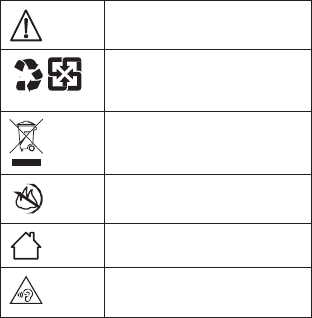
3
Operational warnings.
Obey all posted signs when using mobile
devices in public areas.
•
Potentially explosive areas:
Potentially explosive areas are often, but
not always, posted and can include blasting areas, fueling stations,
fueling areas (such as below decks on boats), fuel or chemical transfer
or storage facilities, or areas where the air contains chemicals or
particles, such as grain dust, or metal powders.
Turn off your mobile device before entering such an area, and do not
charge batteries. In such areas, sparks can occur and cause an explosion
or fire.
•
Symbol key:
Your charger, mobile device, battery (if user- removable),
device display, user’s guide, or packaging may contain symbols, defined as
follows:
Important safety information follows.
Your battery or mobile device may require
recycling in accordance with local laws. Contact
your local regulatory authorities for more
information.
Don’t dispose of your battery or mobile device
with your household waste. See Disposal &
recycling for more information.
Don’t dispose of your battery or mobile
device in a fire.
For indoor use only.
Listening at high volume to music or voice
through a headset or headphone may damage
your hearing.
Supported frequencies and power.
This device is capable of
operation on the following frequencies, subject to location and network
availability.
Model XT
19
22-9 XT1922-6 XT1922-7
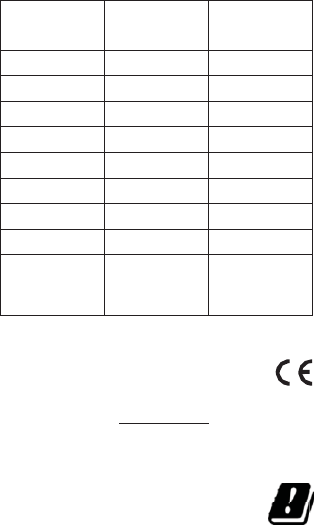
4
Operating mode
Frequency
range
MHz
/
Band
Maximum nominal
transmit
power
(conducted)
dBm
Bluetooth
2400 – 2483.5
20
WLAN
2400 – 2483.5
20
WLAN
5150-5725
23
WLAN
5725-5850
14
GPS/GLONASS
1559 - 1610
N/A
FM Receive
87.5– 108
N/A
GSM
2/3/5/8
32.5
UMTS
1/2/4/5/8
23.5
LTE
1/2/3/4/5/7/8/12/13
14/17/25/26/29/30/
38/41/66
24
European conformance
(CE).
The following information is applicable to
mobile devices that carry a CE mark. Contact point: Regulatory Compliance,
Motorola Mobility UK Ltd., Redwood, Crockford Lane, Chineham Business
Park, Basingstoke, RG24 8WQ, UK.
Hereby, Motorola Mobility LLC declares that the radio equipment
with this declaration and bearing the CE mark is in compliance with
Directive 2014/53/EU.
The full DoC can be found at www.motorola.com/red. Use the search feature
to find your device’s model or type. Your device’s model
and type may be under the battery, under the rear cover, or on the exterior
of the device.
Restrictions of use.
This product may be used in the following
European member states subject to the following restrictions. For
products that support Wi-Fi 802.11a/ac (as defined in your product
information): Outside the United States, this device is restricted to
indoor use when
operating in the 5.15 to 5.35 GHz (802.11a) Wi-Fi frequency band.

5
AT
BE
BG
CH
CY
CZ
DE
DK
EE
EL
ES
FI
FR
HR
HU
IE
IS
IT
LI
LT
LU
LV
MT
NL
NO
PL
PT
RO
SE
SI
SK
TR
UK
FCC and IC compliance.
[en-US, fr-CA] This device complies with part
15 of the FCC rules. Operation is subject to the following two conditions: (1)
this device may not cause harmful interference, and (2) this device must
accept any interference received, including interference that might cause
undesired operation. This device complies with Industry Canada license-
exempt RSS standard(s). Operation is subject to the following two
conditions: (1) this device may not cause interference, and (2) this device
must accept any interference received, including interference that might
cause undesired operation.
Hearing Aid Compatibility (HAC).
[US Only] The US
performance rating system for HAC compliant wireless phones is
as follows: the “M” (microphone) indicates that the product has
been tested and rated for acoustic coupling. The “T” (telecoil)
represents that the product
has been tested and rated for inductive coupling. The higher the “M” or “T”
rating (such as “M3/T4”), the less likely the hearing aid user will experience
interference when the hearing aid is set to the respective microphone or
telecoil mode.
For more information and a list of HAC ratings by model, visit www.
motorola.com/hacphones. To enable the ‘Hearing Aid’ feature on your phone:
Phone > Menu > Settings > Accessibility > Hearing aids
(see the User
Guide for more).
Service & Repairs.
If you have questions or need assistance, we’re
here to help. Go to www.motorola.com/support, where you can select
from a number of customer care options.
Copyright & Trademarks.
MOTOROLA, the stylized M logo, MOTO, and
the MOTO family of marks are trademarks or registered trademarks of
Motorola Trademark Holdings, LLC. LENOVO is a trademark of Lenovo. All
other product or service names are the property of their respective owners.
© 2018 Motorola Mobility LLC. All rights reserved.
Manual Number: TBD-A
Motorola Mobility LLC
222 W. Merchandise Mart Plaza
Chicago, IL 60654
www.motorola.com
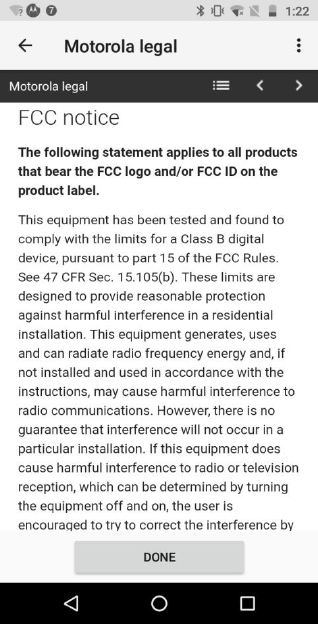
6
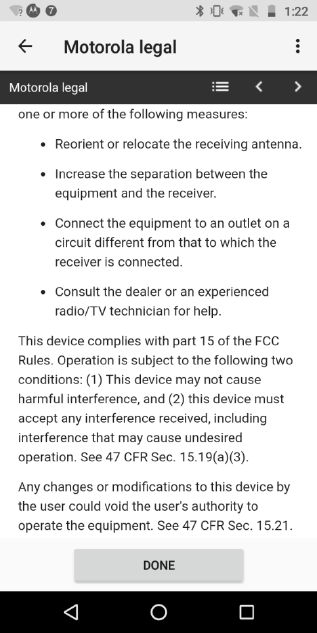
7
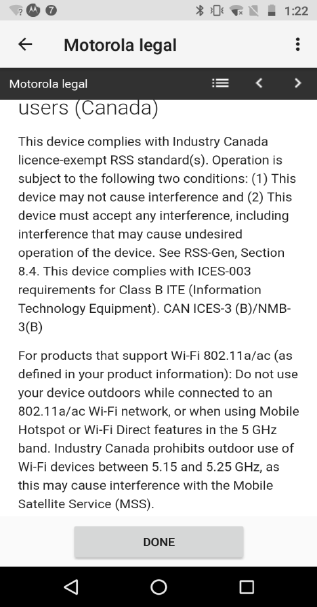
8
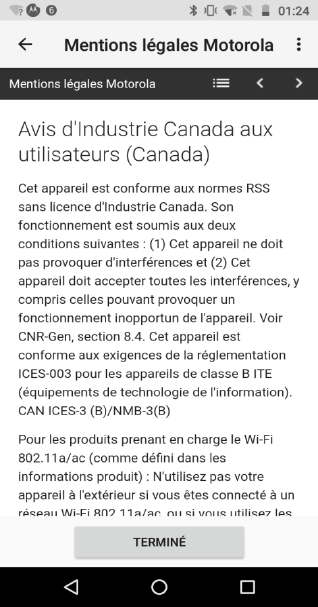
9
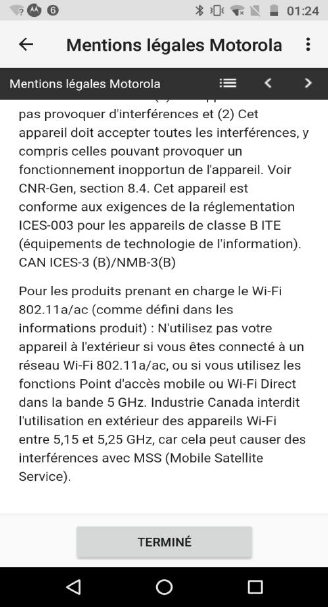
10
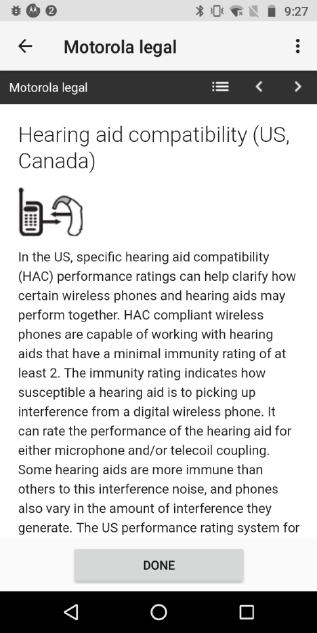
11
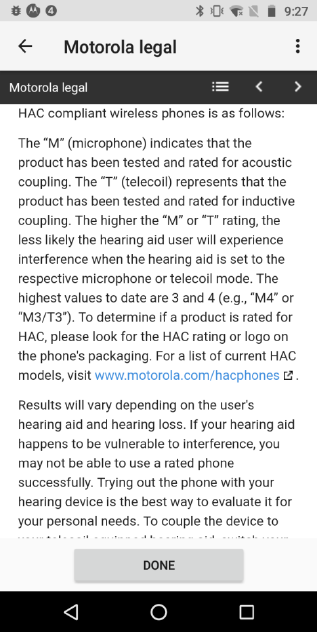
12
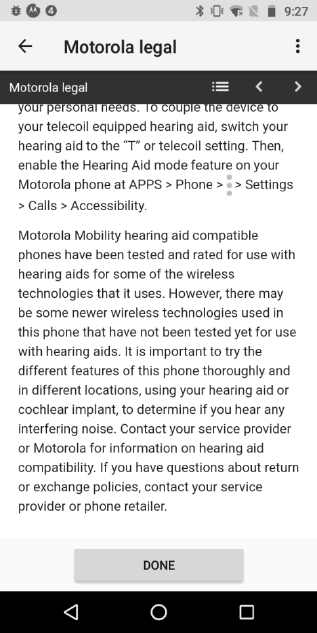
13
DONE